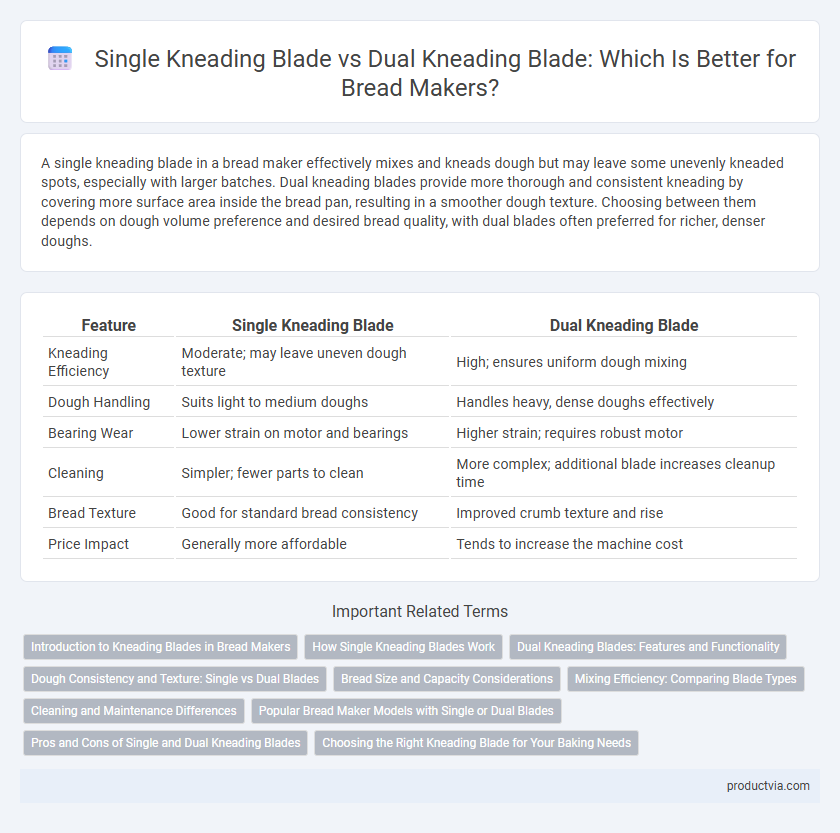A single kneading blade in a bread maker effectively mixes and kneads dough but may leave some unevenly kneaded spots, especially with larger batches. Dual kneading blades provide more thorough and consistent kneading by covering more surface area inside the bread pan, resulting in a smoother dough texture. Choosing between them depends on dough volume preference and desired bread quality, with dual blades often preferred for richer, denser doughs.
Table of Comparison
| Feature | Single Kneading Blade | Dual Kneading Blade |
|---|---|---|
| Kneading Efficiency | Moderate; may leave uneven dough texture | High; ensures uniform dough mixing |
| Dough Handling | Suits light to medium doughs | Handles heavy, dense doughs effectively |
| Bearing Wear | Lower strain on motor and bearings | Higher strain; requires robust motor |
| Cleaning | Simpler; fewer parts to clean | More complex; additional blade increases cleanup time |
| Bread Texture | Good for standard bread consistency | Improved crumb texture and rise |
| Price Impact | Generally more affordable | Tends to increase the machine cost |
Introduction to Kneading Blades in Bread Makers
Single kneading blades in bread makers typically provide efficient dough mixing for standard recipes, offering simplicity and ease of cleaning. Dual kneading blades enhance dough consistency by thoroughly mixing ingredients and reaching more areas inside the pan, ideal for denser bread types or larger batches. Selecting between single and dual blades depends on specific baking needs, such as bread texture preferences and recipe complexity.
How Single Kneading Blades Work
Single kneading blades in bread makers operate by rotating to mix ingredients and develop gluten, ensuring even dough consistency. These blades are typically positioned centrally at the bottom of the bread pan, providing thorough kneading for standard loaf sizes. Their simple design minimizes mechanical issues, making them reliable for everyday bread preparation.
Dual Kneading Blades: Features and Functionality
Dual kneading blades in bread makers offer enhanced dough mixing efficiency by mimicking hand-kneading motions, resulting in thoroughly mixed and evenly textured dough. These blades operate simultaneously at different angles, ensuring consistent kneading and minimizing the risk of uneven ingredient distribution or product collapse. Their design supports a wider variety of bread types, including dense or whole-grain recipes, by providing superior dough development compared to single blade models.
Dough Consistency and Texture: Single vs Dual Blades
Single kneading blades tend to produce an uneven dough consistency as they may miss parts of the mixture, leading to less uniform texture in the finished bread. Dual kneading blades ensure thorough mixing and consistent dough development by better distributing ingredients throughout the bowl. This results in a more uniform crumb structure, improved rise, and a superior, even texture in homemade bread.
Bread Size and Capacity Considerations
Single kneading blade bread makers typically accommodate smaller loaf sizes, ranging from 1 to 2 pounds, making them ideal for compact kitchens and individuals with limited bread consumption. Dual kneading blade models support larger loaf capacities, often up to 3 pounds or more, ensuring thorough dough mixing and better texture for big families or frequent bakers. Choosing between single or dual blades depends largely on the desired bread size and the frequency of baking needs, with dual blade machines providing superior performance for larger batches.
Mixing Efficiency: Comparing Blade Types
Dual kneading blades in bread makers provide superior mixing efficiency by evenly distributing ingredients and reducing mixing time compared to single blades. The simultaneous rotation of two blades ensures thorough dough development, leading to better texture and rise in the final loaf. Single kneading blades may struggle with denser doughs, resulting in less consistent mixing and potentially uneven crumb structure.
Cleaning and Maintenance Differences
Single kneading blade bread makers typically require less cleaning effort due to fewer parts and simpler design, making maintenance quicker and easier. Dual kneading blade models can provide more thorough dough mixing but often involve more complex cleaning processes, as each blade and coupling must be carefully washed and dried to prevent residue buildup. Choosing between the two depends on balancing preferred dough consistency with the time available for regular cleaning and upkeep.
Popular Bread Maker Models with Single or Dual Blades
Popular bread maker models with single kneading blades include the Zojirushi Home Bakery Virtuoso and the Cuisinart CBK-100, known for consistent dough mixing and simplified cleaning. Dual kneading blade designs, featured in the Sunbeam Programmable Bread Maker and Oster ExpressBake, offer enhanced dough kneading efficiency for denser or larger batches. Choosing between single or dual blades depends on desired bread texture and baking capacity preferences.
Pros and Cons of Single and Dual Kneading Blades
Single kneading blades in bread makers offer simplicity, easy cleaning, and generally lower cost, but may produce less thorough dough mixing and uneven texture. Dual kneading blades enhance dough consistency by better distributing ingredients and improving gluten development, resulting in a smoother, more evenly kneaded dough, though they can complicate cleaning and increase appliance price. Choosing between single and dual blades depends on balancing convenience and budget against desired bread quality and texture.
Choosing the Right Kneading Blade for Your Baking Needs
Single kneading blades are ideal for basic bread recipes, efficiently mixing dough with minimal effort and easy cleaning, while dual kneading blades offer superior kneading performance, especially for dense or large batches, ensuring even gluten development. Choosing between a single or dual blade depends on your baking frequency, dough types, and desired bread texture, with dual blades providing more consistent results for complex recipes. Opt for a dual kneading blade if you frequently bake artisan or whole grain breads, as it enhances dough elasticity and rise.
Single kneading blade vs Dual kneading blade for bread makers Infographic

 productvia.com
productvia.com